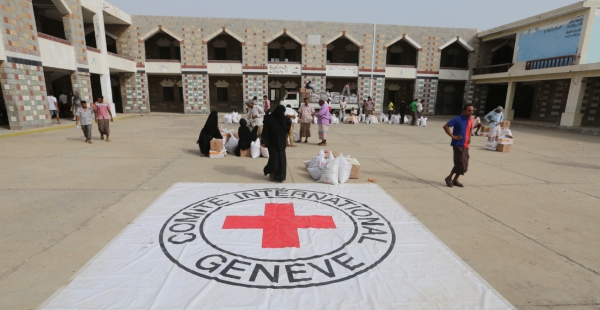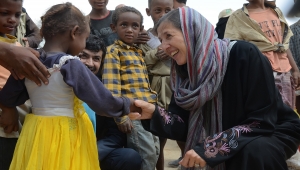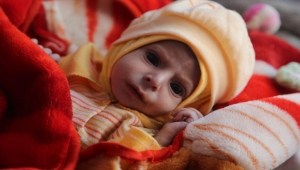
[ Yemen: Forgotten Women Amid a Forgotten War ]
Yemen’s civil war has raged since 2015 but amid reporting on violence, disease and food insecurity, the impact of the conflict on women is often overlooked.
Mariam (a pseudonym) was 24 years old and seven months pregnant with her third child when she died. She had spent her whole life in Hodeidah, Yemen’s Red Sea port city. In September 2018, the country’s civil war forced her to flee when her home was destroyed by an airstrike. Seeking refuge with her two children in a small town where her husband had joined the fighting, Mariam found shelter in a school shared with dozens of displaced families. Pain in her belly led her to seek help from the families who collected enough money for Mariam to travel to a rural hospital for treatment. The midwife who received her recognised the symptoms of a premature birth and admitted her to the labor room. But the baby was in a position where it couldn’t be delivered normally. The midwife was unable to maneuver it ready for birth. The hospital’s only obstetrician – the only one in the whole district – had just left, after working for two years without salary.
The only way to save Mariam and her child was to refer them to a private hospital. An ambulance made the transfer but Mariam was turned away at the hospital door, unable to pay for the treatment she needed. A cesarean section can cost up to US $300 in Yemen, with patients asked to pay in advance before being granted admission. Mariam was sent back to the rural hospital, where nothing could be done to save her and the baby.
Mariam’s story is not rare or unusual in Yemen, a country torn apart by a conflict that erupted in 2015 and still seems far from over. Hodeidah has been a focal point of the fighting since June 2018. In 2013, Yemen’s estimated ratio of women dying as a result of complications from pregnancy was 148 per every 100 000 live births according to Demographic Health Survey data. By the onset of the civil war in 2015, it had more than doubled to 365 deaths per 100 000 according to UNFPA estimates. Data collection has now become increasingly challenging. There are no longer any updated figures on how many women survive childbirth. Considering the complete collapse of the Yemeni health system, chances are that more and more women are dying in childbirth. These deaths are not being recorded in any health information systems.
In Italy, where I am from, this “maternal mortality ratio” is four deaths for every 100 000 live births. This means that an obstetrician working 300 days per year for 40 years, attending an average of five deliveries per day, might easily end their career without ever seeing a women die from pregnancy. The same obstetrician working in Yemen would see an average of one maternal death every two months. This stark comparison demonstrates the inequities of both access to health care and the possibility of survival for Yemeni women.
The journey of a pregnant woman to give birth can be a dangerous one in Yemen. The steps of that journey are striking examples of how difficult things that we take for granted have become – like health care. Women in Yemen often need permission from the head of the household to seek health care services. They need money to afford journeys to health facilities – journeys that can take up to five hours. They need hope that they won’t be delayed at checkpoints. They need hope that the hospital is still standing, knowing that half of all primary health centres in Yemen are no longer fully functional and are the target of direct attacks. Even if the hospital remains standing, there is no guarantee that it has the necessary drugs or equipment to deal with the cases it receives. On the other hand, medicine and equipment are of little use if there are no skilled health professionals available – often the case given that most have not received their salary for the past two years or more.
Much has been written about Yemen and the dramatic cost of the ongoing conflict on its citizens. Yet few crises in the world have less evidence about the impact of conflict on women. Without solid evidence on existing needs and gaps in care, it is extremely difficult for organisations planning humanitarian health interventions to grant a relevant response. The International Committee of the Red Cross (ICRC) is one of the organisations playing a key role in these responses. Its health intervention assists war wounded and victims of violence across the continuum of care – from first aid, stabilisation and prehospital care, to surgical care at hospital level and physical rehabilitation services. It also assists the general population through the support of preventative and curative primary health services. The objective of the latter is to “make the invisible visible” and to reach the most vulnerable and voiceless in this conflict.
For the close to 700 ICRC staff in Yemen, supporting efforts to reinforce critical public infrastructure, like health-care facilities, is a key operational priority that can assist those who are overlooked. The ICRC provides support to 38 health centres across Yemen – including 28 near the front lines of the conflict. It supports 17 hospitals and nine physical rehabilitation projects. Although the needs of women and children often go unheard and undocumented in this conflict, we have not forgotten them. It is our job to focus on providing assistance so that no more “Mariams” are lost when they have so much reason to live.
*Claudia Truppa is Deputy Health Coordinator, International Committee of the Red Cross, Yemen.


